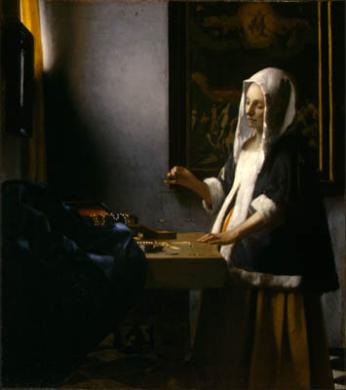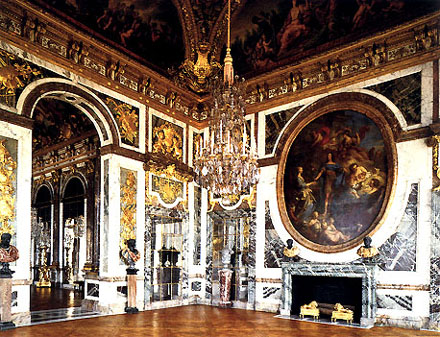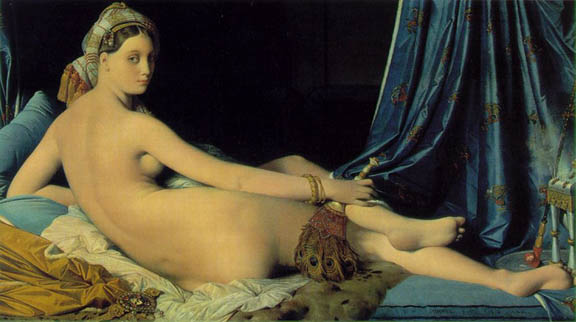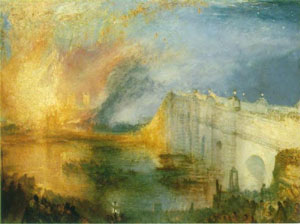

Posted on 01/23/2006 10:42:54 AM PST by Republicanprofessor
Finally, what with a snow day and all, I have time to write one more installment of the history of art. Today’s “lesson” is Baroque art.
Baroque art dates from 1600-1715 or so. (The dates are different with different media. The end of Baroque art coincides with the death of King Louis XIV in 1715; Baroque music ends with the death of Bach in 1750.) The expansion in Baroque artistic space reflects the expansion of political empires (into the New World) and the expansion of scientific knowledge (the invention of microscopes and telescopes: with space expanding outward and contracting inward).
Thus in art, we see a dynamic use of space and light, dramatic energy, and diagonals in three main styles:
1) naturalistic style: Caravaggio, Rembrandt, Vermeer and others.
2) dynamic illusionistic style: very busy, mix of different painting, sculpture, architecture, seen in the work of Rubens, Bernini and others.
3) classicizing, classical Baroque: Greco-Roman mythology, togas, drapes, etc. In architecture we have classical columns, pediments, seen at Versailles. In painting, Poussin rules.
In Italy, Caravaggio reacts against weird Mannerism and returns to a dynamic realism. Quite often his works jut dramatically into our space. He wanted to bring the Catholic faith down to earth, and uses real people and often peasants as his models. The church was shocked by the bare feet and did not appreciate his work at all. (The church preferred the more fancy, dynamic ceiling paintings we’ll see soon.)


Bronzino’s strange Mannerist Venus, Cupid, Folly and Time mid 16th century; and reacting against such odd Mannerism is Caravaggio’s Conversion of St. Paul early 17th century
Note the strong diagonals, dynamic and dramatic light. Also, note what takes up most of the composition: the rear end of a horse!! No wonder the church did not like Caravaggio’s work much. (He also led a rowdy life: hanging out in bars, once stabbing a waiter when he was dissatisfied with his meal, not to mention his gay proclivities.)
Also worth mentioning is Artemesia Gentileschi, whom I see as the first great woman artist. She was inspired by Caravaggio but reflects female power in her image of the Beheading of Holofernes. The power (and revengeful feeling?) in this piece may come from Gentileschi’s rape at the age of 19 by her art teacher.

Note how the maidservant leans back to avoid getting splattered with blood, and that Judith has strong, powerful arms; she is no mild weakling.
Up in Holland, Rembrandt was inspired by the light and down-to-earth realism of Caravaggio. He had a more Protestant, touch, however, and also a warmth and personal depth of characters in his work. I’ve already discussed the love and yet marital differences in The Jewish Bride in another thread (http://www.freerepublic.com/focus/f-chat/1552989/posts). What I also admire is Rembrandt’s Prodigal Son. Notice the great love and forgiveness of the father, yet the towering brother (who stayed behind to help his dad and did not go off and waste his fortune) resounds with resentment.


Rembrandt was also one of the first with a life long series of self-portraits that show increasing internal anxiety as he aged.


There are many other great naturalistic Baroque painters of the seventeenth century, especially Vermeer and van Ruisdael. Instead of the Catholic church as a sponsor, these painters had to market their pieces to the public, and, as a result, often specialized (in landscapes, seascapes, still lifes, etc.) for better sales.


As a mother, I particularly love the Vermeer: Woman with a Balance. I see her as weighing the importance of the jewels (on the left) with the imminent birth of her child and how that will change her life. It is hard to see the balance; there is actually nothing in it.
Now the dynamic illusionistic style is best seen in the Flemish style of Peter Paul Rubens. (Flemish refers to the country of Flanders, now Belgium. It remained strongly Catholic in the religious wars which swept Europe in the 16th century.)


Here we have Rubens famous Daughters of Leuicippus being abducted (“raped”) by Castor and Pollux and his ecstatically religious Assumption of the Virgin. I think he is either an artist one likes strongly or dislikes strongly. As I am learning in the (fabulous) Rape of the Masters: How Political Correctness Sabotages Art by Roger Kimball, Rubens was actually a model of self-control in his personal life (despite his “over the top” paintings).
In Italy, Bernini was another dynamic illusionistic, “over the top” artist. He was the sculptor of the Trevi Fountain, the interior “church furniture” of the Basilica of St. Peter’s, and the famous Ecstasy of St. Theresa shown below.


Then there are the many ceiling paintings of the Italian and Austrian Baroque, where one is almost sucked up into a swirling heaven of bodies. This, too, can be too much for some viewers. I think, however, that the effect is somewhat lost if you are not standing in the very church itself.

Finally, no Baroque art lecture is complete without a consideration of Versailles. This “hunting lodge” was expanded by Louis the XIV, the notorious absolute monarch, who brought his entire court to Versailles so that he could control them. And control he did; he ruled from 1665-1715. It is his death that ends the Baroque art style, as there is a lightening and relaxation of form and content after his death (see below).
The French Baroque is more classical and controlled on the exterior of the building, but just as dynamically busy on the interior. The gardens also extend for miles, with a typically tight French control.



It was under Louis XIV that the third Baroque style blossomed. This is the classical Baroque style and under Poussin it really thrived. Here we see an almost Renaissance kind of restraint. The forms are balanced but not symmetrical. Poussin established the French Academy, and all its rules, against which the Impressionists would rebel 150 years later.

Now, just one slide from the Rococo period, which followed the Baroque period. Forms become lighter and “fluffier.” My favorite is The Swing by Fragonnard. What’s that man doing in the lower left? Can you see him looking up her skirt? Has anything changed in 275 years? What is interesting is the oblivious priest who pushes her swing. The foliage is more like the down from pillows than it is like real trees. Nothing is “realistic” and it appears more dream like. Love themes predominated during the Rococo(movies like Valmont and Dangerous Liaisons come to mind).

The next period is the Neoclassical period, beginning about 1787 with David’s paintings such as Oath of the Horatii, which erases all the light and fluffy aristocratic love themes with a return to Greco-Roman morality and heroism.

At this point, I have just one more of these basic “lectures” to write: on Neoclassicism and Romanticism. Stay tuned.
Very good.
Actually, the kid in the first piece is Venus' son Cupid...not exactly a normal mother/son relationship.:)
As yo Bahama Mama, I'm tied up right now with the FReeps Ahoy 4 cruise and have little time to post comments in depth on this or other threads. But I have to let you know how much I appreciate your efforts.
I wish you could come on the cruise with us. I'd arrange for an art lecture by you for our freepers in some quiet ship's salon.
What could be more enjoyable than to hear you speak while a gently-waving sapphire-blue seascape rolls past as we gaze out the picture windows.
Leni
Let me know about your next cruise. That could be fun.
Hey, the places I really want to cruise are the Greek Islands and Istanbul. I am dying to see Hagia Sophia, and I think this could be a great way to see it.
For future thoughts....
Have fun on your cruise. We miss your insights, but life intervenes quite often...
Good question.
Romanticism is the 19th century reaction to Neoclassicism, adding a freedom of color and expression. The broken color will influence the Impressionists.



One of my favorite comparisons: Odalisques (Harem women) by the Neoclassical Ingres and the Romantic Delacroix. Also a quite abstract work of the Burning of the Houses of Parliament by Turner, who took Romanticism as far toward abstraction as it could go back then.
Expressionism is a more extreme 20th century movement. Yes, it does express emotion through color and loose brushstrokes.



The Street by Kirchner, and two by Kandinsky: one an early one and one much later and quite non-objective (with no basis in the real world at all). You can see that the use of color and shape is more extreme than the earlier Romanticism.
Thank for this thread and the ping. Great artwork.
Thank you! That really answered my question.
Thank you for the link. I had not known of the other Caravaggio until I did a search for this very post. That Michelangelo is a very unusual work by him, rather Mannerist and anti-Renaissance. It is surprising that it is at the Vatican. The other, early Medieval piece was new to me.
Thanks again.
Are you thinking of chiaroscuro? Light/Dark? Leonardo was the first to use such dramatic contrasts, but Caravaggio took it to a new, dramatically lit height.
Certain things could be touched upon in more detail: the influence of Michelangelo on Carravaggio, the contrast between the sumptuous Catholic paintings of Flanders versus the simpler pious paintings of Holland, and Rembrandt contributing a milestone to the art world with his "painterliness".
Disclaimer: Opinions posted on Free Republic are those of the individual posters and do not necessarily represent the opinion of Free Republic or its management. All materials posted herein are protected by copyright law and the exemption for fair use of copyrighted works.